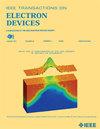Electrostatic Discharge and Failure Model of Carbon Nanotube Field-Effect Transistors
IF 2.9
2区 工程技术
Q2 ENGINEERING, ELECTRICAL & ELECTRONIC
引用次数: 0
Abstract
The electrostatic discharge (ESD) and failure mechanisms of carbon nanotube field-effect transistors (CNT FETs) were thoroughly investigated via transient current tests and numerical simulations. Experiments demonstrated that CNT FETs have a three-stage ESD process according to transmission-line pulse (TLP) and human-body model (HBM) measurements, vastly different from the snapback phenomenon in conventional Si CMOS transistors. As the drain bias (碳纳米管场效应晶体管的静电放电和失效模型
通过瞬态电流测试和数值模拟研究了碳纳米管场效应晶体管(CNT fet)的静电放电(ESD)和失效机理。实验表明,根据传输在线脉冲(TLP)和人体模型(HBM)测量,碳纳米管场效应管具有三级ESD过程,与传统Si CMOS晶体管的snapback现象有很大不同。当漏极偏置(${V} _{\text {DS}}$)从2 V增加到12 V时,碳纳米管场效应管的ESD机制由热离子发射(第一级)转变为带间隧穿(第二级),产生动态放电阻抗。漏极到栅极隔离电介质的软击穿在第三级产生放电电流,击穿电流引起的碳纳米管场效应管发热会对漏极到栅极隔离电介质和金属触点造成严重损坏,最终导致器件失效。因此,漏极-栅极隔离介质被认为是弱点,需要优化以提高碳纳米管场效应管的可靠性。
本文章由计算机程序翻译,如有差异,请以英文原文为准。
求助全文
约1分钟内获得全文
求助全文
来源期刊

IEEE Transactions on Electron Devices
工程技术-工程:电子与电气
CiteScore
5.80
自引率
16.10%
发文量
937
审稿时长
3.8 months
期刊介绍:
IEEE Transactions on Electron Devices publishes original and significant contributions relating to the theory, modeling, design, performance and reliability of electron and ion integrated circuit devices and interconnects, involving insulators, metals, organic materials, micro-plasmas, semiconductors, quantum-effect structures, vacuum devices, and emerging materials with applications in bioelectronics, biomedical electronics, computation, communications, displays, microelectromechanics, imaging, micro-actuators, nanoelectronics, optoelectronics, photovoltaics, power ICs and micro-sensors. Tutorial and review papers on these subjects are also published and occasional special issues appear to present a collection of papers which treat particular areas in more depth and breadth.
 求助内容:
求助内容: 应助结果提醒方式:
应助结果提醒方式:


